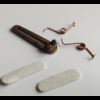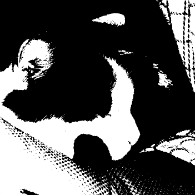-
Posts
1,395 -
Joined
-
Last visited
Contact Methods
-
Website URL
http://www.chrisghentconcertinas.au
Profile Information
-
Gender
Not Telling
-
Location
Blue Mountains NSW
Recent Profile Visitors
5,167 profile views
Chris Ghent's Achievements

Heavyweight Boxer (5/6)
-
I’d be thinking 180 was the number of this concertina. Something pencilled in could be a working number, a batch number etc. Once the punches come out it is serious and final.
-
Richard, thanks for that thought, it would be easily done. I have a reversal of the high c#/bf button on the last button g row but I have never used it so wouldn’t miss it. I’ll keep the last button accidental row the same for the moment and have two instances of push A. Off to the shed!
-
If you mean the third button on the accidental row, my octagonal instruments are 76mm. The button I have trouble reaching is the last button on the accidental row both sides as my little finger is shorter by a lot. The RHS is of more consequence as it has a reverse second octave A. I have thought, if I ever make myself another instrument I may bring that button preternaturally closer. I have 30mm handrests on my own instruments and I usually fit 25 mms. If anyone has an instrument they love except for being unable to reach the accidental row easily, it is possible with most instruments to modify the rest so it is closer to the buttons by sanding the rest so it leans forward, or by making a wedge to sit under the rest to lean it forward. Sanding the rest itself effectively lowers it so an extra wedge is a better solution. It is also a good idea to drill new holes in different locations through the end as the old holes are now on the wrong angle. If you do not glue the wedge on it will all be very reversible.
-
There is a number in this shot next to the middle buttons, punched into the action board in black numerals. You could email the Dippers and quote that number, ask them what you want.
-
I think every English made concertina would have come with a semi-decent case. The vertical cases I associate with Lachenal and Jeffries. It is a pain to need to store such lovely boxes on their side but it is not hard to make a good case for that to be the best way. Yes, intended. maybe fix the lock?
-

Questions re: setting up a Nanuk 908 case
Chris Ghent replied to Oberon's topic in General Concertina Discussion
Long term the lining materials need to be non friable and much synthetic material becomes friable over time. Anything hairy needs to not shed hair. Those fine fibres will inevitably end up in a reed. Nothing much bonds well to the plastic in these cases. Contact glue will do OK if there is enough contact area and as long as no peeling action is involved in getting the instrument in and out. You can’t fix things through the case side because they are very thin. I use soft leather covering over cotton waste padding, its about 15mm thick and I bought this from an outfit called Clarke Rubber, a known chain store in Aus. It was cotton a while ago and whether what they sell is still cotton I don’t know. These days I feel lucky if the shop is still there when I go back. I glue it on with contact. For narrow gaps I do the same as Alex. With cases a lot depends on what you want the case to do. Vintage cases have no actual padding and if dropping the case the only thing guaranteed is no surface marks. If you want padding, how much is enough? DHL recommend you pack as if the parcel might be dropped 6ft. Thats like someone standing on the tray of a truck dropped it to the ground. Off the top of my head, 2” or 50mm of softer slower packing might do it. For falling off a table maybe 1”/25mm? -
Tom, I don’t understand the meaning of pressure “differential”. Some time ago I spent time gauging the starting vacuum of reeds as a way to producing more efficient reeds. In the tuning rig (which has a variable voltage fan and two magnehelic gauges, one a 0 to .5”) I found reeds needed to start at less than .1” WC to be efficient. The full power of the rig peaks at 1.6”WC which I use as a tuning -pressure. I no longer use this starting assessment method because I know what I need to do to achieve that result and see no need to check it every time. Consequently when the operating pressure in the bellows (I drilled a hole in the bellows frame and sealed a tube into it) turned out to be less than .1 I was a little surprised but accepted it. It was easy to create -pressure of many inches in the bellows but as soon as I pressed a button it dropped away to almost nothing. I’m not saying you are wrong, more that our experiences must be complimentary in some way and I don’t know what that way is. Happy to be wrong myself. Cheers Chris
- 45 replies
-
- anglo
- electronic
-
(and 2 more)
Tagged with:
-
Tom, I don’t understand the meaning of pressure “differential”. Some time ago I spent time gauging the starting vacuum of reeds as a way to producing more efficient reeds. In the tuning rig (which has a variable voltage fan and two magnehelic gauges, one a 0 to .5”) I found reeds needed to start at less than .1” WC to be efficient. The full power of the rig peaks at 1.6”WC which I use as a tuning -pressure. I no longer use this starting assessment method because I know what I need to do to achieve that result and see no need to check it every time. Consequently when the operating pressure in the bellows (I drilled a hole in the bellows frame and sealed a tube into it) turned out to be less than .1 I was a little surprised but accepted it. It was easy to create -pressure of many inches in the bellows but as soon as I pressed a button it dropped away to almost nothing. I’m not saying you are wrong, more that our experiences must be complimentary in some way and I don’t know what that way is. Cheers Chris
- 45 replies
-
- anglo
- electronic
-
(and 2 more)
Tagged with:
-

Pros and Cons of Midi Concertinas
Chris Ghent replied to Paul_Hardy's topic in General Concertina Discussion
I had an early instrument converted to Hall effect midi and it is not perfect but it is a huge amount of fun. It has a pressure sensor inside for volume, which works reasonably. I don’t doubt it could be done better but that will come. The instrument represented, the key and the octave can be shifted by button press. The thrill of sounding like a large church organ is endless. My major issue with it is it cannot distinguish between a tipped button and a fully pushed button. If ever the concertina became a fashionable instrument again it will not be through an old fusty playing a 1926 Aeola, it will be a young thing with a midi made of something fantastic with flashing lights. All power to them. -
Years ago I connected a magnehelic gauge to a bellows and was amazed to find the operating pressure inside was minimal. By memory it was .025” water column. The force applied to fingertips should be no more than about 60 grams times the number of buttons pushed and is separate to the pushing or pulling action. It will be there whether pushing the bellows or pulling. I think I would ignore it. You would only need to fit your gadget to the active end of the concertina. However there are many different ways people hold an anglo and simple pressure in and out on the handrest leads to waggle in the bellows leading to more complex ways of holding and bracing the movement.
- 45 replies
-
- anglo
- electronic
-
(and 2 more)
Tagged with:
-
A job well done Dana! If anyone has not seen inside one of Dana’s concertinas, there is a lot of lovely well thought out engineering in there. And thanks Dana for all of the good sense you put my way over the years. And the great company on our many phone calls..!
-

Troubleshooting leaky action box
Chris Ghent replied to RogerT's topic in Instrument Construction & Repair
I find carefully lifting the end off the action box, making sure the end is perfectly positioned and lifting vertically so as to not disturb any of the buttons or the pads, will show you where the pads are positioned on the pad board. Only works with a concertina that has inscribed circles around the pads as an alignment guide. When I made concertinas without such a circle I would put a dot in the centre of the pad so the alignment could be gauged from underneath. These alignment methods only work in conjunction with oads in good condition and no extraneous matter caught underneath.



.thumb.jpeg.09943e9e2f2a23918324c6151aa2597b.jpeg)




